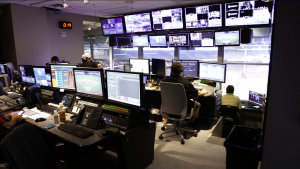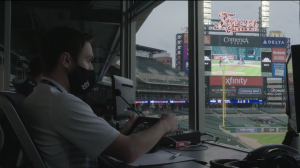At the Ballpark: How MLB Teams Produce a Fan-less In-Venue Experience
Similarities include safety measures, rehearsals, fabricated crowd noise
Story Highlights
2020 has forced the industry to roll with the punches that came with the COVID-19 pandemic and to pivot strategies for adapting to this new era of live sports production. When Major League Baseball decided to postpone competition until late July and prohibit fans from attending games, in-venue staff across the nation needed to figure out how to operate videoboard elements without their priority audience. SVG’s At the Ballpark Series takes you inside the control room to learn the similarities and differences of producing a spectator-less show.
MORE AT THE BALLPARK INTERVIEWS:
- New York Mets’ In-Venue Show Entertains Players On-Field
- Mariners Productions Keeps Players, Onsite Staff on Schedule With In-Venue Routine at T-Mobile Park
- Detroit Tigers Focus on Fan Engagement, Rely on Scrimmages for In-Venue Strategy
Upper Tier: COVID-19 Protocols Present New Logistical Challenges
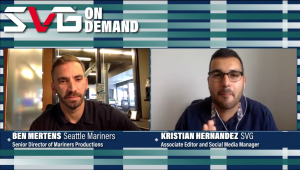
Mariners Productions’ Ben Mertens: “The team has absolutely crushed it so far. Without them, we couldn’t be doing what we’re doing.”
While other leagues have opted for bubble environments, MLB forged ahead with games played in home ballparks. This choice has come with not only increased testing and other safety requirements for players but medical procedures for in-venue professionals as well.
“Some of us have to take our temperature a couple of times to get two readings, you may have to fill out an application to find out if you have any COVID-19–related symptoms, and, if all that checks out, you’re granted access to come into the ballpark,” says Ben Mertens, senior director, Mariners Productions. “When you pull into the stadium, you almost go through the same process again. Once you get through all of that, you get to walk into the building.”
Along with temperature checks outside the stadium and re-testing inside, COVID-19 has produced a complex tiering system that limits entry to certain parts of the ballpark to designated employees. Players, coaches, and essential personnel who work directly with the production team have access to Tier 1. Tier 2 comprises individuals who may come into contact with Tier 1. In-venue crews make up a portion of the third tier.
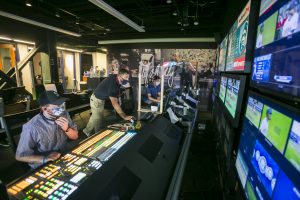
Ben Mertens (standing) and his Mariners Productions colleagues power in-venue elements from the control room in T-Mobile Park.
With this system in place, behind-the-scenes access has been decreased exponentially. This is being done to prevent a potential outbreak, but the result is that the majority of the content featuring players comes from the action on the field.
“There’s a sense of safety when you get there, but it’s a challenge,” says Joe Devito, executive producer, content and marketing, New York Mets. “You can’t get the camera angles that you normally want, so it’s a positive challenge to say, ‘How do we still deliver high-quality content and bring the fan into the game without having as much access as we would normally have?’ There are times when I would have a camera follow Pete Alonzo into the clubhouse after a big win, but I can’t do that anymore. We’re relying on collaboration with the rest of our staff at different access levels, and everyone has been great at filling in those blanks that are now part of this situation.”
Making Some (Fake) Noise: Development of Fabricated Crowd Sounds
One of the hardest adjustments has been the added responsibility of executing fake crowd noise. The league has provided an iPad packed with familiar sounds and chants deriving from the popular MLB The Show videogame. The role of an audio mixer is usually a difficult one, but, to pull off this effort, production teams have deployed a pair of mixers who handle stadium music and crowd noise, respectively.
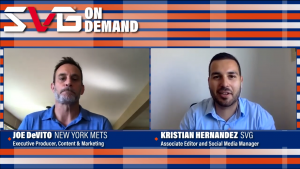
New York Mets’ Joe Devito: “There’s nothing that I could possibly do without all of these folks. Everyone has been unbelievable throughout this season so far.”
Fans realize that the seats are empty (or populated by cardboard cutouts), but, with a suspension of disbelief, this dual-headed audio effort is giving a sense of auditory realism to games. It’s a tough job that requires maximum focus from those involved.
“To do it well,” Mertens explains, “you have to be paying close attention to the game. You can’t be checking your phone or having a conversation with somebody on comms, because you don’t know when something’s going to happen in the game of baseball. Getting the sense and rhythm of a game but also watching previous broadcasts and understanding what it sounds like were key points in the learning process.”
Producing this aspect of a show is a major focus, but the audio system is being used for more than just automated crowd noise. With players as the main audience, teams are constructing playlists of music that cater to the home players on the field.
Summer Camp: Scrimmages Offer Extra Production Reps
With the start of the season delayed a couple of months, intrasquad scrimmages began occurring in each stadium and were ultimately treated as a second Spring Training or Summer Camp. While broadcasters used these games to learn the nuances of this odd season, in-venue teams leveraged this downtime to get comfortable with what was to come.
“We used those games as a testing ground to see how the crowd noise would play out, how the players would feel about it, how it would actually sound in the ballpark, and how loud we needed to make it,” says Stan Fracker, director, broadcasting and in-game entertainment, Detroit Tigers. “Ballpark sound systems are designed to provide audio to the fans in the seats, not necessarily to the teams on the field, so we had to adjust audio levels to be able to understand that it’s actually reaching the playing field at a level that has an impact.”
Creating and coordinating videoboard elements became a priority during these scrimmages, but a lot of the practice time was also dedicated to resolving issues that came with crowd noise. Relationships with respective regional sports networks have become even stronger to make the on-air product sound more authentic.
“The other consideration is that most of the people that are hearing this crowd noise will be listening to it at home on the broadcast,” says Fracker. “With that in mind, we also had to work with our broadcast partner and make sure that the sound was at an appropriate level.”
Special Opportunity: Teams Embrace the Uniqueness of Abbreviated Season
In a season of much uncertainty, all the teams face the same challenges. Even so, each crew has adopted plans of attack that differ in several ways. For example, Mariners Productions is continuing a good chunk of its normal routine as a timing mechanism.
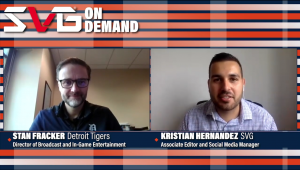
Detroit Tigers’ Stan Fracker: “The team has really embraced it, and the response has been great across the board.”
“We’re still using simple things like the national anthem or the starting lineups,” notes Mertens. “They’re consistent in the show that we run, so the players use that as cues for themselves to say, ‘Hey, this is where I should be in my game prep.’ We’re providing that consistency that they’re used to.”
DeVito and the Mets, for their part, are committed to providing extra energy and entertainment to the team.
“We’re still playing our hype video when the team takes the field, rally videos when we’re going into the later innings, and a lot of music,” says DeVito. “We’d like to think that gives the players a little juice and pumps them up a little bit before performing. When we look down [at the field] and see them looking up at the board to watch, enjoy, and, sometimes, we understand that we were the ones that gave them that content and that moment.”
Despite these differences, this peculiar season is soaked in opportunity from an in-venue perspective. From more creative freedom to finding a new identity without raucous fans in the stands, it’s certain to become an unforgettable year.
“We’re starting to get more comfortable with the new situation,” says Mertens. “I can’t imagine what we’re going to continue to come up with and how creative we’re going to be during the remaining part of the season.”
Stay tuned for At the Ballpark interviews with the Los Angeles Dodgers, Minnesota Twins, Cincinnati Reds, Tampa Bay Rays, and Arizona Diamondbacks!
